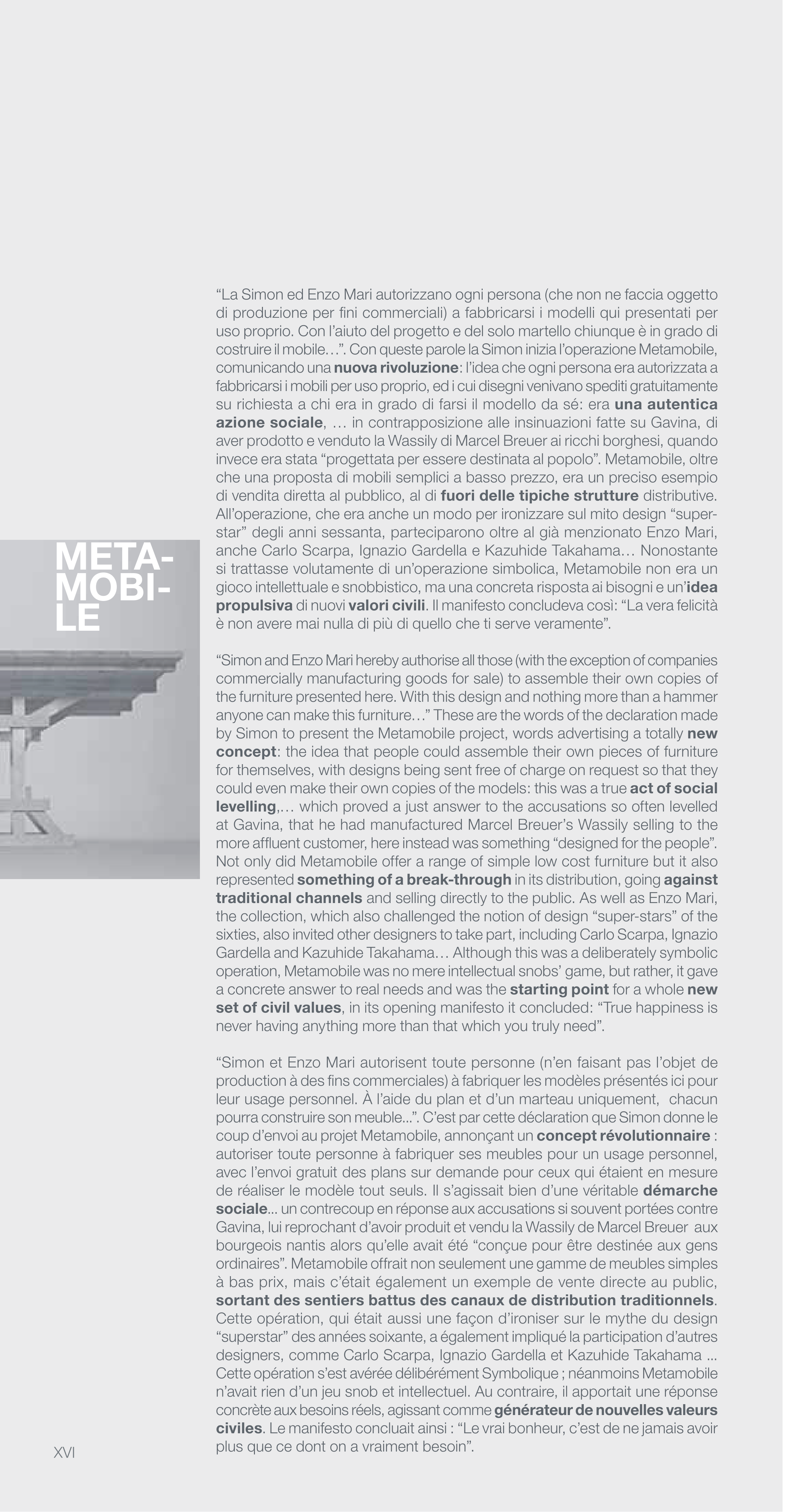“La Simon ed Enzo Mari autorizzano ogni persona (che non ne faccia oggetto
di produzione per fini commerciali) a fabbricarsi i modelli qui presentati per
uso proprio. Con l’aiuto del progetto e del solo martello chiunque è in grado di
costruire il mobile…”. Con queste parole la Simon inizia l’operazione Metamobile,
comunicando una nuova rivoluzione: l’idea che ogni persona era autorizzata a
fabbricarsi i mobili per uso proprio, ed i cui disegni venivano spediti gratuitamente
su richiesta a chi era in grado di farsi il modello da sé: era una autentica
azione sociale, … in contrapposizione alle insinuazioni fatte su Gavina, di
aver prodotto e venduto la Wassily di Marcel Breuer ai ricchi borghesi, quando
invece era stata “progettata per essere destinata al popolo”. Metamobile, oltre
che una proposta di mobili semplici a basso prezzo, era un preciso esempio
di vendita diretta al pubblico, al di fuori delle tipiche strutture distributive.
All’operazione, che era anche un modo per ironizzare sul mito design “super-
star” degli anni sessanta, parteciparono oltre al già menzionato Enzo Mari,
anche Carlo Scarpa, Ignazio Gardella e Kazuhide Takahama… Nonostante
si trattasse volutamente di un’operazione simbolica, Metamobile non era un
gioco intellettuale e snobbistico, ma una concreta risposta ai bisogni e un’idea
propulsiva di nuovi valori civili. Il manifesto concludeva così: “La vera felicità
è non avere mai nulla di più di quello che ti serve veramente”.
“Simon and Enzo Mari hereby authorise all those (with the exception of companies
commercially manufacturing goods for sale) to assemble their own copies of
the furniture presented here. With this design and nothing more than a hammer
anyone can make this furniture…” These are the words of the declaration made
by Simon to present the Metamobile project, words advertising a totally new
concept: the idea that people could assemble their own pieces of furniture
for themselves, with designs being sent free of charge on request so that they
could even make their own copies of the models: this was a true act of social
levelling,… which proved a just answer to the accusations so often levelled
at Gavina, that he had manufactured Marcel Breuer’s Wassily selling to the
more affluent customer, here instead was something “designed for the people”.
Not only did Metamobile offer a range of simple low cost furniture but it also
represented something of a break-through in its distribution, going against
traditional channels and selling directly to the public. As well as Enzo Mari,
the collection, which also challenged the notion of design “super-stars” of the
sixties, also invited other designers to take part, including Carlo Scarpa, Ignazio
Gardella and Kazuhide Takahama… Although this was a deliberately symbolic
operation, Metamobile was no mere intellectual snobs’ game, but rather, it gave
a concrete answer to real needs and was the starting point for a whole new
set of civil values, in its opening manifesto it concluded: “True happiness is
never having anything more than that which you truly need”.
“Simon et Enzo Mari autorisent toute personne (n’en faisant pas l’objet de
production à des fins commerciales) à fabriquer les modèles présentés ici pour
leur usage personnel. À l’aide du plan et d’un marteau uniquement, chacun
pourra construire son meuble...”. C’est par cette déclaration que Simon donne le
coup d’envoi au projet Metamobile, annonçant un concept révolutionnaire :
autoriser toute personne à fabriquer ses meubles pour un usage personnel,
avec l’envoi gratuit des plans sur demande pour ceux qui étaient en mesure
de réaliser le modèle tout seuls. Il s’agissait bien d’une véritable démarche
sociale... un contrecoup en réponse aux accusations si souvent portées contre
Gavina, lui reprochant d’avoir produit et vendu la Wassily de Marcel Breuer aux
bourgeois nantis alors qu’elle avait été “conçue pour être destinée aux gens
ordinaires”. Metamobile offrait non seulement une gamme de meubles simples
à bas prix, mais c’était également un exemple de vente directe au public,
sortant des sentiers battus des canaux de distribution traditionnels.
Cette opération, qui était aussi une façon d’ironiser sur le mythe du design
“superstar” des années soixante, a également impliqué la participation d’autres
designers, comme Carlo Scarpa, Ignazio Gardella et Kazuhide Takahama ...
Cette opération s’est avérée délibérément Symbolique ; néanmoins Metamobile
n’avait rien d’un jeu snob et intellectuel. Au contraire, il apportait une réponse
concrète aux besoins réels, agissant comme générateur de nouvelles valeurs
civiles. Le manifesto concluait ainsi : “Le vrai bonheur, c’est de ne jamais avoir
plus que ce dont on a vraiment besoin”.
META-
MOBI-
LE
XVI


